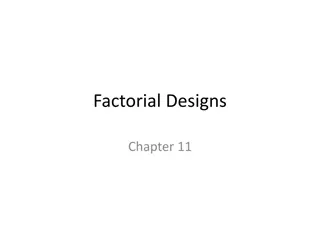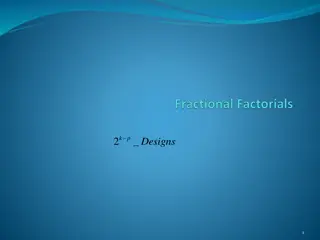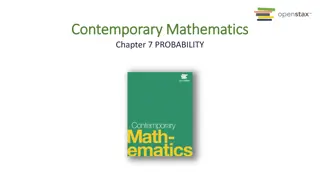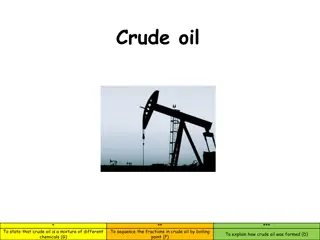Understanding Special Topics in Design: Factorial Experiments and Fractional Designs
This content delves into the world of factorial designs used in design experiments to identify important factors and interactions. It explores 2k full factorial designs and their application in screening potential factors. Additionally, the content discusses 2k-p fractional factorial designs and the importance of obtaining estimates of main effects and lower-order interactions. Various experiments and plots are presented to visualize the effects and outcomes of these designs.
Download Presentation

Please find below an Image/Link to download the presentation.
The content on the website is provided AS IS for your information and personal use only. It may not be sold, licensed, or shared on other websites without obtaining consent from the author. Download presentation by click this link. If you encounter any issues during the download, it is possible that the publisher has removed the file from their server.
E N D
Presentation Transcript
Special Topics In Design A Brief Survey
2kFull Factorial Designs Used to screen through several potential factors to determine a subset of important factors and interactions Obtains estimates of effects of each factor and interaction as well as sums of squares for the ANOVA (very few if any df for error) All factors are set at -1/+1 for low and high levels of the factor Normal probability plot of estimated effects reveals important factors Run 1 2 3 4 5 6 7 8 label (1) c b bc a ac ab abc I A -1 -1 -1 -1 1 1 1 1 B -1 -1 1 1 -1 -1 1 1 C -1 1 -1 1 -1 1 -1 1 AB 1 1 -1 -1 -1 -1 1 1 AC 1 -1 1 -1 -1 1 -1 1 BC 1 -1 -1 1 1 -1 -1 1 ABC -1 1 1 -1 1 -1 -1 1 Y 2 k 1 4 1 4 2 4 ( ) ^ A ^ A ( ) 1 1 1 1 1 1 1 1 y_(1) y_c y_b y_bc y_a y_ac y_ab y_abc = + + + + + + = y y y y y y y y SS (1) a ac ab abc c b bc A 2 k 1 4 1 4 2 4 ( ) ^ ^ ( ) = + + + + + + = AB y y y y y y y y SS AB (1) c ab abc b bc a ac AB 2 k 1 4 1 4 2 4 ( ) ^ ^ ( ) = + + + + + + = ABC y y y y y y y y SS ABC (1) c b a abc bc ac ab ABC
2kFull Factorial Experiment in Bath Oil Dispersion Factor A Rapeseed Lecithin Ethanol Soluble Fraction (-1=8, +1=12) Factor B Anhydrous Ethanol (-1=5, +1=15) Factor C Polysorbate 80 (-1=1, +1=3) Response Dispersion Degree of Bath Emulsions Run label (1) c b bc a ac ab abc A B C AB AC BC ABC Y 3.489 2.843 3.868 4.323 3.281 3.76 2.905 2.722 1 2 3 4 5 6 7 8 -1 -1 -1 -1 1 1 1 1 -1 -1 1 1 -1 -1 1 1 -1 1 -1 1 -1 1 -1 1 1 1 1 1 -1 1 1 -1 1 -1 -1 1 -1 1 -1 -1 1 -1 1 -1 -1 1 1 -1 -1 1 -1 -1 -1 -1 1 1 Effect SumSq -0.4638 0.4301 0.1113 0.0248 0.0263 0.0014 -0.8183 1.3391 0.1218 0.0296 0.1098 0.0241 -0.4408 0.3885 2.2376
AB Interaction Plot 4.3 4.1 3.9 3.7 Dispersion Degree 3.5 B=-1 3.3 B=+1 3.1 2.9 2.7 2.5 -1 1 Factor A
Normal Probability Plot of Effect Sizes 2 1.5 The 3 large negative effects (AB, A, ABC) fall far from the line formed by the smaller (in absolute value) effects 1 0.5 Normal Quantile 0 -0.5 -1 -1.5 -2 -1 -0.8 -0.6 -0.4 -0.2 0 0.2 Effect
2k-p Fractional Factorial Designs As the number of factors k increases, the total number of runs for the full factorial increases multiplicatively to 2k Usually researchers are interested in main effects and effects corresponding to lower order interactions Goal is to choose a fraction of the full factorial design that can obtain estimates of main effects and lower-order interactions (which will necessarily be confounded with higher order interactions Makes use of Incomplete Block Designs to obtain the fraction of the full replicate. Defining contrasts (available in general design textbooks and on the web) are available to select a design for general k and p
2k-p Fractional Factorial Designs Depending on k and p, the level of confounding will depend on their levels. The Resolutions of designs are typically reported: Resolution III Main Effects are confounded with 2-factor interactions, and pairs of 2-factor interactions are confounded Resolution IV No main effects are confounded with other main effects or 2- factor interactions, pairs of 2-factor interactions are confounded Resolution V No pairs of main effects or 2-factor interactions are confounded, pairs of 2-factor and 3-factor interactions are confounded Defining Contrasts: Factor labels can be raised to powers (0 mod 2): A1 = A, A2 = A0 = I Set I equal to the effects used to create incomplete blocks Each effect will be confounded with 2p-1 other effects These can be obtained by multiplying the effects through defining relation
2k-p Fractional Factorial Examples Example 1 k=4, p=1 (Half-replicate, with 8 runs) Confound 4-Way Interaction with 2 Blocks of Size 8 I=ABCD (or could use I=-ABCD) Confounded Effects: A=AI=AABCD=A2BCD=BCD, B=ACD, C=ABD, D=ABC, AB=CD, AC=BD, AD=BC Bold runs below are used in experiment ((1),cd,bd,bc,ad,ac,ab,abc) This Design is Resolution IV Run 1 2 3 4 5 6 7 8 9 10 11 12 13 14 15 16 Label (1) d c cd b bd bc bcd a ad ac acd ab abd abc abcd A -1 -1 -1 -1 -1 -1 -1 -1 1 1 1 1 1 1 1 1 B -1 -1 -1 -1 1 1 1 1 -1 -1 -1 -1 1 1 1 1 C -1 -1 1 1 -1 -1 1 1 -1 -1 1 1 -1 -1 1 1 D -1 1 -1 1 -1 1 -1 1 -1 1 -1 1 -1 1 -1 1 AB 1 1 1 1 -1 -1 -1 -1 -1 -1 -1 -1 1 1 1 1 AC 1 1 -1 -1 1 1 -1 -1 -1 -1 1 1 -1 -1 1 1 AD 1 -1 1 -1 1 -1 1 -1 -1 1 -1 1 -1 1 -1 1 BC 1 1 -1 -1 -1 -1 1 1 1 1 -1 -1 -1 -1 1 1 BD 1 -1 1 -1 -1 1 -1 1 1 -1 1 -1 -1 1 -1 1 CD 1 -1 -1 1 1 -1 -1 1 1 -1 -1 1 1 -1 -1 1 ABC -1 -1 1 1 1 1 -1 -1 1 1 -1 -1 -1 -1 1 1 ABD -1 1 -1 1 1 -1 1 -1 1 -1 1 -1 -1 1 -1 1 ACD -1 1 1 -1 -1 1 1 -1 1 -1 -1 1 1 -1 -1 1 BCD -1 1 1 -1 1 -1 -1 1 -1 1 1 -1 1 -1 -1 1 ABCD 1 -1 -1 1 -1 1 1 -1 -1 1 1 -1 1 -1 -1 1
2k-p Fractional Factorial Examples Example 2 k=5, p=2 (Quarter-replicate, with 8 runs) I = ABE = CDE = ABCD (Cochran & Cox (1957), Plan 6A.2, page 277 Quarter Replicate (8 Runs) Run Label 2 8 26 32 abcde 11 13 19 21 Alias Structure Effect1 I A B C D E AC AD A -1 -1 1 1 -1 -1 1 1 B -1 -1 1 1 1 1 -1 -1 C -1 1 -1 1 -1 1 -1 1 D -1 1 -1 1 1 -1 1 -1 E 1 1 1 1 -1 -1 -1 -1 ABE 1 1 1 1 1 1 1 1 CDE 1 1 1 1 1 1 1 1 ABCD 1 1 1 1 1 1 1 1 Effect2 ABE BE AE ABCE ABDE AB BCE BDE Effect3 CDE ACDE BCDE DE CE CD ADE ACE Effect4 ABCD BCD ACD ABD ABC ABCDE BD BC e cde abe bd bc ad ac Note: This Design is Resolution III Runs with A=+1: 26, 32, 19, 21 Runs with A = -1: 2, 8, 11, 13 Runs with BE = +1: 26, 32, 19, 21 (B and E are both +1 or -1) Runs with BE = -1: 2, 8, 11, 13 Effects and Sums of Squares can be obtained for: A/BE, B/AE, C/DE, D/CE, E/CD, AC/BD, and AD/BC
Response Surface Designs Goal: Find values of numeric predictor variables that optimize the output variable of a process. Second-Order Model contains all main effects, quadratic terms, and 2-way interactions in a regression equation. Model with k predictors: 1 k k k k E Y = + + + = + + 2 i x ' ' X X X X x x 1 2 0 ' ' 0 i i ii i i ii = 1 ' = i i = + = 1 1 1 i i i k 2 2 2 X X 1 1 11 12 1 k 2 2 2 12 22 2 k = = = x where 1 2 2 2 X 1 2 k k k k kk 1 k k k ^ ^ ^ ^ ^ ^ ^ = + + + = + + 2 i x Fitted (OLS)Values: ' ' Y X X X X x x 1 2 0 ' i ii ii ' 0 i i i = 1 ' = i i = + = 1 1 1 i i i ^ 1 1 2 Y x ^ ^ set = ^ ^ = + = * 2 is the "optimal" point for max/min of the response surface x 0 x 1 2 1 2
Response Surface Central Composite Design Factors are set at 3 equally spaced levels, coded as -1/0/+1 2k factorial design is set up at each combination of +/-1 2k points are set where one factor is set at +/- and all other factors are set at 0. is often set at 1.414, 1.682, or 2 c points are set at the center, with each factor is set at 0 F-test for Lack-of-Fit is conducted due to replication at the center point Total sample size 2k + 2k + c Designs are often replicated in blocks
Example Damaged Rice in Bioethanol Production Experiment with 3 Factors in utilizing damaged rice in Bioethanol Factors: Malt Extract Concentration, Yeast Inoculum Concentration, Fermentation Time Responses: Ethanol Concentration, Yeast Cell Yield, Utilized Reducing Sugars Run_ID maltExt.C ystInoc.C fermTm.C maltExt -1 -1 1 -1 -1 1 1 1 -1 -1 1 -1 -1 1 1 1 -1.68 0 1.68 0 0 -1.68 0 1.68 0 0 0 0 0 0 0 0 0 0 0 0 ystInoc fermTm ethConc ystCell 1.58 1.36 2.07 1.69 2.39 0.71 2.52 0.68 4.72 2.97 0.48 0.9 0.76 0.98 2.98 2.92 3.08 3.06 utilSug 1 2 3 4 5 6 7 8 9 -1 -1 -1 -1 1 1 1 1 0 0 0 0 1.5 4.5 1.5 4.5 1.5 4.5 1.5 4.5 0.48 5.52 2 2 5 5 2 2 5 5 1.5 1.5 1.5 1.5 3.5 3.5 3.5 3.5 2.5 2.5 2.5 2.5 0.82 4.18 2.5 2.5 2.5 2.5 8.39 8.26 8.72 8.1 8.24 8.02 8.5 7.92 8.99 8.35 7.87 7.88 8.43 7.93 8.35 8.3 8.35 8.28 13.22 14.98 14.11 13.25 11.95 8.32 16.95 10.51 22.86 16.84 9.12 11.77 7.94 9.97 17.27 18.88 17.82 18.12 3.5 3.5 0.98 6.02 3.5 3.5 3.5 3.5 3.5 3.5 10 11 12 13 14 15 16 17 18 3 3 3 3 3 3 3 3 -1.68 1.68 0 0 0 0
Results of Regression Y=Ethanol Concentration SUMMARY OUTPUT Regression Statistics Multiple R R Square Adjusted R Square Standard Error Observations 0.9980 0.9960 0.9914 0.1079 Beta1 -0.4050 2.9082 4.8383 18 Beta2 ANOVA 0.1218 -0.0089 -0.1217 -0.0089 -0.3751 -0.0300 -0.1217 -0.0300 -0.7801 df SS MS 2.5507 218.9490 0.0116 F Significance F 0.0000 Regression Residual Total 9 8 22.9561 0.0932 23.0493 17 x* 4.2270 3.5925 2.3036 Coefficients -7.1334 -0.4050 2.9082 4.8383 0.1218 -0.3751 -0.7801 -0.0178 -0.2433 -0.0600 Standard Errort Stat 0.4606 -15.4861 0.1205 0.1263 0.1942 0.0135 0.0135 -27.7660 0.0304 -25.6676 0.0170 0.0254 0.0254 P-value Lower 95%Upper 95% 0.0000 -8.1957 0.0099 -0.6828 0.0000 2.6169 0.0000 4.3905 0.0000 0.0906 0.0000 -0.4062 0.0000 -0.8502 0.3252 -0.0569 0.0000 -0.3020 0.0461 -0.1187 Intercept maltExt ystInoc fermTm X1^2 X2^2 X3^2 X1X2 X1X3 X2X3 -6.0712 -0.1271 3.1994 5.2860 0.1529 -0.3439 -0.7100 0.0213 -0.1847 -0.0013 -3.3611 23.0242 24.9186 9.0143 -1.0482 -9.5649 -2.3585
Response Surface Box-Behnken Design Design has k factors, each at 3 levels coded as -1/0/+1 For all k(k-1)/2 pairs of factors, set up a 22 design with coded levels -1/+1, with all other excluded factors being set to level 0 Center points added for a Lack-of-Fit test Example: Experiment in making cordyceps rice wine with k=3 factors: Liquid-to-Solid Ratio, Koji Addition, Temperature Run_ID liqSol.C koji.C tempC.C liqSol koji tempC cordycepin totAcid 44.2 36.31 32.34 32.62 38.27 34.84 40.99 34.22 38.42 32.56 37.61 31.68 41.55 40.12 42.15 42 39.87 1 2 3 4 5 6 7 8 9 -1 1 -1 -1 -1 1 -1 1 0 0 0 0 0 0 0 0 0 -1 -1 1 1 0 0 0 0 -1 1 -1 1 0 0 0 0 0 0 0 0 0 1.5 2.5 1.5 2.5 1.5 2.5 1.5 2.5 6 6 26 26 26 26 24 24 28 28 24 24 28 28 26 26 26 26 26 7.8 7.2 8.1 7.5 7.7 7.1 7.7 7.3 6.6 7.4 7.1 7.4 7.1 7.2 7.3 7.1 7.2 10 10 8 8 8 8 6 10 6 10 8 8 8 8 8 -1 -1 1 1 -1 -1 1 1 0 0 0 0 0 2 2 2 2 2 2 2 2 2 10 11 12 13 14 15 16 17
Mixture Designs Goal: Optimize the response across a set of mixtures among k ingredients, where proportions of ingredients always sum to 1 Similar to Response Surface Designs, Mixture Designs are fit based on linear regression, with the restriction that the Xs sum to 1 Four commonly fit models (all are fit without an intercept based on the full set of predictors): k k k k E Y ( ) = = + = + Linear: 1 X X X X 1 1 1 i i i i i i i = = = = 1 2 2 2 i i i i 1 k k k E Y = + Quadratic: X X X ' ' i i ii i i = 1 ' = i i = + 1 1 i i 1 2 1 k k k k k k E Y = + + Special Cubic: X X X X X X ' ' ' '' ' '' i i ii i i ii i i i i = 1 ' = i i = + = i i = + = + 1 1 1 ' 1 '' ' 1 i i i i i 1 2 1 1 k k k k k k k k E Y ( ) = + + + Scheffe's Cubic Model: X X X X X X X X X X ' ' ' '' ' '' ' ' ' ' i i ii i i ii i i i i ii ii i i i i = 1 ' = i i = + 1 ' = i i = + = + 1 ' = i i = + 1 1 1 '' i ' 1 1 i i i i i
Example Wax Ratio in Lipstick Formulations Experiment used k=3 types of wax in lipstick manufactured with Sweet Almond Oil Formulations (Waxes): Ozokerite, Beeswax, and Candelilla Wax. Responses: Breaking Point (g) and Softening Point ( C) Experimental Runs: 16 Mixtures of the Waxes ExpNum X1 X2 X3 Break Soft 1 2 3 4 5 6 7 8 9 0.2 0 0 0 325.8 239.2 332.9 242.1 247.3 258.9 342.1 343.0 292.5 299.9 399.2 407.6 258.9 326.0 325.1 436.8 62.0 53.0 61.3 58.8 53.3 53.3 61.5 57.8 53.8 52.8 61.3 58.0 53.3 55.0 53.8 59.0 0 0 0.2 0 0.2 0.1333 0.0667 0.0667 0.1333 0.0667 0.0667 0.1333 0.1333 0 0 0 0 0.0667 0.0667 0.0667 0.0667 0.1333 0.1333 0.0333 0.0333 0.0333 0.1333 0.0667 0.1333 0.1333 0 0 10 11 12 13 14 15 16 0.0667 0 0 0.0667 0.0333 0.1333 0.1333 0.0333 0.1333 0.0333 0.0333 0.0333
Summary Results for 4 Models fit in EXCEL SUMMARY OUTPUT Linear SUMMARY OUTPUT Quadratic Regression Statistics Multiple R R Square Adjusted R Square Standard Error Observations CM SSTot_2 SSReg_2 dfReg_2 R^2_2 F_2 1611186 55263.17 9982.372 Regression Statistics Multiple R R Square Adjusted R Square Standard Error Observations CM SSTot_2 SSReg_2 dfReg_2 R^2_2 F_2 1611186 55263.17 28316.34 0.9863 0.9728 0.8917 59.0181 0.9919 0.9838 0.8757 51.9103 Total and Regression Sums of Squares and R2 and F are incorrect due to fitting regression through origin. They are corrected for each model 2 2 0.1806 1.4330 0.5124 5.2541 16 16 ANOVA ANOVA df SS MS F Significance F 0.0000 df SS MS F Significance F 0.0000 Regression Residual Total 3 1621168 540389.4 155.1444 45280.8 3483.139 1666449 Regression Residual Total 1639502 273250.4 101.4035 10 26946.83 2694.683 16 1666449 6 13 16 SUMMARY OUTPUT Special Cubic SUMMARY OUTPUT Scheffe's Cubic Regression Statistics Multiple R R Square Adjusted R Square Standard Error Observations CM SSTot_2 SSReg_2 dfReg_2 R^2_2 F_2 1611186 55263.17 28961.29 Regression Statistics Multiple R R Square Adjusted R Square Standard Error Observations CM SSTot_2 SSReg_2 dfReg_2 R^2_2 F_2 1611186 55263.17 41904.77 0.9921 0.9842 0.8626 54.0595 0.9960 0.9920 0.8133 47.1848 2 2 0.5241 4.9550 0.7583 9.4109 16 16 ANOVA ANOVA df SS MS Significance F 80.1753 F df SS MS Significance F 74.2494 F Regression Residual Total 7 9 26301.89 2922.432 16 1666449 1640147 234306.7 0.0000 Regression Residual Total 10 6 13358.41 2226.401 16 1666449 1653091 165309.1 0.0001























